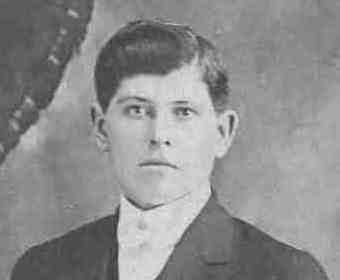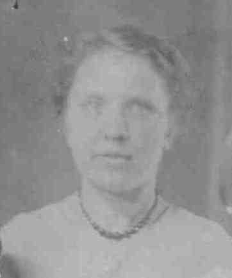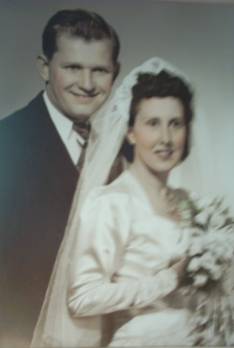
THE VOICE OF INTERNATIONAL LITHUANIA
|
VilNews has its own Google archive! Type a word in the above search box to find any article.
You can also follow us on Facebook. We have two different pages. Click to open and join.
|
by KR Slade


My grandfather Jonas Sladkevicius and grandmother Dominyka Juskeviciute Sladkeviciene
In 1960, my father told me that a member of our family was a bishop in Lithuania. It was there, when part of Czarist Russia, where my grandmother and grandfather had been born sometime in the last decade of the 1800's, from where they emigrated to Rhode Island in the United States where they would meet and marry in 1915. The information about the bishop came from the two Lithuanian-born priests at our Providence, RI church, Saint Casimir’s, where my father attended mass daily since he was a child. Dad also told me, “Don’t tell anybody”. We never again discussed the subject.
The secrecy about things-Lithuanian was already familiar to me by that time, when I was twelve. Details or actual proof of anything about Lithuania was rare. Lithuania was on the other side of the Iron Curtain. Russians (then meaning Communists) could and would make things difficult for those of our family still in the Lithuanian Soviet Socialist Republic, as well as for a missing few of the family presumed to have been sent to Siberia in eastern Russia. Furthermore, didn’t Russian secret agents murder the Lithuanian President early during World War II, when he was in exile in the United States?
Now, fifty years later, I have found, albeit accidentally, the absolute proof that the bishop is my cousin. He was born August 20, 1920, ordained March 25, 1944, named a bishop on November 14, 1957. Sadly, the bishop died on May 28, 2000. Equally sad, my father died in 1981, and would never know that our bishop would become a cardinal.
Bishop Vincentas Sladkevicius was named, in pectore, to the office of a Cardinal of the Roman Catholic Church in 1979 by Pope John Paul II. The Latin phrase is best translated ‘in the breast (heart)’; it means ‘secretly’: not even the bishop knew he was a cardinal until it was publicly announced on June 28, 1988. In fact, most Lithuanians (especially in Lithuania) did not know that Bishop Sladkevicius was a bishop, because upon his consecration the communist government immediately put him into ‘internal exile’, a form of house-arrest, sending him to a remote place in Lithuania (Birstonas village), not allowing him to perform his duties, and with a guard stationed outside his countryside house, which he was not allowed to leave, and where everyone visiting was threateningly examined and harassed.
I found the proof that I was a cousin of the Cardinal after being in Lithuania one year, and one month, one week, and one day. But I had not been looking for proof of my family relationship to the Cardinal; I had been looking for further proof of my Lithuanian descent, so as to obtain state recognition of my Lithuanian citizenship. I came to Lithuania to claim my inherent birth right, by both descent and ethnicity, as a citizen of Lithuania.
In the United States, before leaving for Lithuania, I had obtained about a dozen official documents such as birth, death, and marriage certificates of my parents and my paternal grandparents; and I had further affidavits from the funeral director of my parents, grandmother, and grandfather; all documents gave full and complete testimony as to my Lithuanian descent. These documents were government-certified, with the signatures and seals recognized throughout the United States.
When I arrived in Lithuania, the Ministry of the Interior would not recognize the documents because of a missing and required ‘apostille’. I had practiced as an attorney-at-law for 24 years in the United States and had never heard of an ‘apostille’. (This legal term has no relation to the Christian ‘apostles’, except perhaps for Doubting-Thomas!) It took a few months to determine how to obtain this continuing legal ‘relic from the past’: a further certification as to the authenticity of the US government-issued documents, for use of the documents abroad.
The Lithuanian Ministry of Foreign Affairs was helpful in assisting me in routing the documents to the Lithuanian Consul in New York City to obtain the required ‘apostille’ certification. This delay of many weeks was followed by the Lithuanian requirement of translating the documents into the Lithuanian language, at a considerable financial cost.
Once the documents were in the correct form, then they could be considered by the Migration Department of the Ministry of the Interior. Under Lithuanian law I am a citizen of Lithuania if my great-grandparents were Lithuanian (meaning ethnic origin) or if they were citizens of Lithuania. Therefore, I was not asking to become a Lithuanian citizen, such as by ‘naturalization’, I was asking for the state’s recognition that I was a Lithuanian citizen, by reason of my birth/ancestry.
The Migration Department made an administrative decision that my documents were not sufficient to grant recognition of my citizenship. This decision was made by unknown and unidentified persons, for no given reason(s), and with no right of internal appeal.
The Migration Department therefore sent the ‘not-approved’ application to the Presidential Commission, which has the authority to determine such ‘questionable’ applications. The file reached the Commission a few weeks after the President of Lithuania was impeached and removed from office: on grounds that included wrongfully granting a citizenship through this Commission. Although the Commission has the legal right to meet with applicants, hear witnesses, and take additional evidence, the Commission summarily denied my application. Their official record of consideration of my application consists of one sentence in which they recommend no citizenship. The decision contains no finding of facts, no conclusions of law, and no reasons. The certified decision document states their names, but bears no signature.
This record was ‘secret’; only after my bringing a lawsuit against the Commission would they release their record. They released the record one week after the Court ruled that they ‘had a reason’, and that therefore the decision was proper, even though this ‘reason’ was given to the court after the fact of the Commission’s decision. The Court would not consider my new evidence, because such evidence was obtained after the decision of the Commission.
My new evidence consisted of a certified copy of the report of the Archives of Lithuania showing: my grandfather was born on January 20, 1897 in the village of Guronys (in Zasliai), and baptized on February 9, 1897 in the parish church in the small town of Zasliai. The record shows his parents to be Jonas and Ona. Most importantly, but not so unusual, was the fact that his mother, Ona had the maiden name of Sladkevicius; she and her husband were distant cousins. This fact of the same family name would become very important in identifying family members, where 25 percent of the males were named Jonas (John) and 25 percent of the females were named Ona (Anna/Ann).
When I submitted the official Archive document to the Migration Department they responded with a letter that they cannot consider further applications from me because I have a case against them. After the court case had been decided, in their favour, I resubmitted the evidence. That was 8 November 2004 and it is now more than four months later; I have received no response.

My parents’ wedding, 1947.
On the first of November 2004, I went to the church at Zasliai. All Saint’s Day is the time that Lithuanians gather to remember deceased members of their family. At the graveyard, I found two graves with the name Sladkevicius, but their birth dates were too recent to be my ancestors. I did not know that I was at the wrong graveyard.
In mid-February 2005, I returned to Zasliai with Father Peternal, a Catholic priest from Wyoming who has been in Lithuania for ten years. We met with the parish priest, Father Klimas. When he saw the archive certificate of my grandfather, he showed us a hand-written manuscript of notes and charts detailing the Cardinal’s family history. I took a look at it, but could not make any sense of the document. He told us where to find the farmsteads of the Sladkevicius family, their family graveyard, and the large rock with the new memorial plaque for the Cardinal, where there will be a park to his memory. We wandered around in the snow of Guronys. From the edge of the forest at the hilltop cemetery with the many Sladkevicius graves, we saw a train. That railroad existed before my grandfather was born, and it could have taken a teenage boy (of almost 18 years-of-age) away from conscription into the Czars army for World War I, out of the Lithuania then called Russia, and to a boat to America.
With wet feet, we drove to Lithuania’s second-largest city, Kaunas, for the second half of our excursion. Beside the cathedral, at the Cardinal Sladkevicius Museum, we had an appointment with the director. I was introduced to Irena; she stared at me, took two steps to the side to see my profile, and said, “Of course. Same nose, same mouth, same between. All the Sladkevicius look like that.”
Irena began working for the Cardinal about 10 months before he died. She is a journalist who wrote the first book about him; his reaction was, “Why did you do that?” After his death she wrote a memorial book about his life. The two books are to be edited into one.
In this building the Cardinal lived the last ten years of his life; more than half of which he was ill with cancer. This ‘palace’ is not especially grand. The first floor is under renovation and had been used for administrative offices. The Cardinal’s apartments were on the second floor. There is a very large room used for receptions. There is a chapel for some dozen persons. She showed us the small room that was the Cardinal’s bedroom: a bed, a desk, a chair. Here he died. His death was after many years of suffering. He refused traditional medicine. “I will suffer like Christ on the cross.”
Irena was present when he died. The priest giving the Last Rites said, “Dear God, open Your gates of heaven, and let in Your servant.” That’s when he died. It was a very moving experience to touch his bed and pray there.
Irena showed us a copy of the genealogy manuscript of the Cardinal; this was the updated annex of the original that had been shown to us by Fr. Klimas in Zasliai. She insisted that I borrow it.
After many long hours over several days of examining the 53 pages of the Annex, I began to be able to read the handwriting, to translate the Lithuanian words, to understand the research methodology. The research shows the ancestors of the Cardinal, and it also shows his relatives who are my ancestors. The ‘family tree’ goes back to the early 1700's, almost 100 years before the Czarist Russian Empire annexed Lithuania. It shows the names, birth and death dates, marriages and dates, children and their dates; it also shows which house in the village that they lived. I am a very distant (4th) cousin of the Cardinal through my great-grandfather; but I am also a closer (3rd) cousin through my great-grandmother.
The author of the research report lives here in Vilnius, about 3 miles from me. I wrote a letter to him. He most graciously agreed to meet with me; we have met a second time. He is now obtaining certified documents from the Archives to prove my great-grandparents’ birth/death and Lithuanian descent and citizenship. The documents will be ready in a few weeks. Antanas has written to other members of the family about me. Last week I received the first correspondence from a relative, an e-mail: “We want to socialize with you.”
Spring is coming. Some documents are coming. Antanas volunteered to go with me to Migration to ask about the status of my 8 November re-application, when I will have some new documents in my briefcase. Summer is coming. There will be a time for me to experience the traditional gathering of families. May 28 is the date of Cardinal’s death, and will be a couple of days after the first anniversary of my application for recognition of my Lithuanian citizenship.
- Bookmark :
- Digg
- del.icio.us
- Stumbleupon
- Redit it
VilNews e-magazine is published in Vilnius, Lithuania. Editor-in-Chief: Mr. Aage Myhre. Inquires to the editors: editor@VilNews.com.
Code of Ethics: See Section 2 – about VilNews. VilNews is not responsible for content on external links/web pages.
HOW TO ADVERTISE IN VILNEWS.
All content is copyrighted © 2011. UAB ‘VilNews’.

 Click on the buttons to open and read each of VilNews' 18 sub-sections
Click on the buttons to open and read each of VilNews' 18 sub-sections 


